Presentation
Since the XVIIth Century, steam began to appear as a feasible new source of energy. In the XIXth more engineers will add their science to bring new innovations into the fray, from the torpedo to the submarine and turbine.
INDUSTRIAL ERA TECH, PIONEERS & ENGINEERS
The century of the Industrial Revolution is also the course of a plethora of pioneers, engineers, architects, inventors, that have disrupted the lives of millions of people by developing machinery. Getting rid of horsepower and manpower has been the focus of many “engineers” since antiquity. Hiero of Alexandria was probably the father of all pioneers in steam power. As early as 50 or 60 AD, he designed the very first practical steam engine, while converting steam to motion in a very simple and compact design: The Aeolipile. However this last has few applications yet but the principle was used to build fancy devices used to produce special effects, notably in temples…
Ideas of exploiting steam power flourished during the renaissance. Even the great Leonardo da Vinci worked on a “rediscovered” marvel of ancient times : Archimedes steam cannon. But it was not before the XVIIth century that those ideas were really put to the test, and far more time before any application on a floating device, other than for show. In The old traditions of the wooden Navy partly explain the very slow transition period that will waive shipping sail only for steam only : The first commercial steamship appears as early as 1810, but the last sailing cargo ships do not disappear until about 1930. Below follows a list of famous engineers, being set up.
Pioneers Engineers of steam
Denis Papin
 The grandfather of steam power.
The grandfather of steam power.
Denis Papin was a french engineer of the XVIIth century. While observing cooking pots, he realized through mathematics and experimentation that vacuum created by steam pressure can be use to pull a mechanical device. So he created a pressure cooker, the steam digester, in 1679. This simple device is still used today in many kitchens… While being a protestant Huguenot, he made most of his career in Prussia and worked with German and British scientists. He made the first piston steam engine in late 1690, and perfected it while in London from 1707 to his death in 1712. However, despite having been destitute from the Royal Society, but his work was a great source of inspiration for Thomas Newcomen.
Thomas Savery
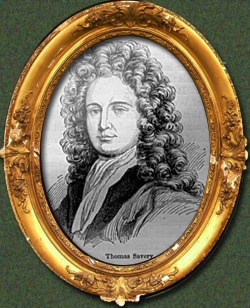
From a pressure cooker to a steam pump.
Thomas Savery (1650-1715) was a military engineer which attempted to create a device to pumping water out from coal mines. He turned about the works of Papain and his steam digester, and created a device capable of using effectively pressure : A cold water sprinkler was used to condense the steam, the vacuum created force out water through the pump with a bottom valve. This was a good device, but with limited motion however, and therefore was not a proper steam engine, but rather a steam vacuum pump, patended in 1698.
Thomas Newcomen

The first patented steam engine.
Working on Papin footsteps, Thomas Newcomen (1663-1729) used both the idea of the steam piston and Savery vacuum pump to create a new model of steam engine, using the motion of a particular device to create a vacuum, rather than a valve only. It became the very first patented steam, one-stroke, controlled engine, also called the atmospheric engine, patended with John Calley, in 1712. It was also used to pump out water form coal mines, but the implied lever principle as the very first practical motion system of its kind. Such “newcomen devices” are still in use roughly unchanged, to extact petroleum. The machinery was used as a base and perfected by James Watt.
Steam engineers in naval history
James Watt
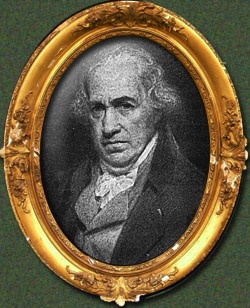
The steam engine reloaded
James watt was a scottish inventor and mechancical engineer (1736-1819) that, while a student in Glasgow university, was given the task to repair the Newcomen engin, then in poor condition. However, he did far better and added several invention of his own to create more pressure and more power. His main upgrading was the 1769 patended separate condenser connected to a cylinder by a valve. This improved machine was the basis of all upcoming steam machines to be built, in England and abroaad, and paved the way for the industrial revolution. His influence was such at the beginning of the XIXth century that the pressure measure was named after him.
Claude Jouffroy d’Abban

The word first steamship.
If Fulton is celebrated as the father of the most reliable, workable steam engine that can used on a ship, in reality it had indeed been preceded by the French mathematician Claude Jouffroy d’Abban. He himself was inspired by fellow Nicolas Cugnot who in 1770 with the goblin gave France its first “steam car” under the form of an artillery tractor. Indeed, Marquis Claude François de Jouffroy d’Abban created a practical, working steamship as early as 1773, with the Pyroscaphe. But after several attemps to have a more powerful engine, the last attempt occurred in 1783 on the river Saône, but eventually was unsuccessful: The machine broke off after only 15 min. of steam motion. However he paved the way for other pioneers to come, although the revolution put an end to further evolutions of these trials in France.
Robert Fulton
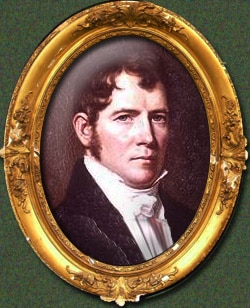
The first practical steamships.
None can claim to be the inventor of something as potent and in such timescale as the steam energy. Fulton, like others, relied on the work already made by Watts and his predecessors. But it is the first to create operationally reliable machines of this type, and the first practical, reliable steamships. But it is also, like many of his contemporaries, a prolific inventor and jack-of-everything: He notably created a practical submersible, called the Nautilus, which was honored by Jules Verne later in his famous “40 000 leagues under the seas”. But Fulton is mostly reckoned with the first reliable ship steam engine ever.
Dupuy de Lôme
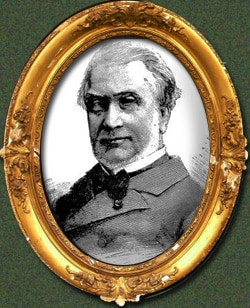
A visionary warship designer.
This French engineer, forenamed Stanislas-Henri-Laurent, born near Lorient, Britanny, headed the Navy’s technical center and was a practical visionary who knew how to get rid of the traditional marine concepts and gave France a number of exceptional ships, leaders of their kind and known precursors : the Napoleon, the first steam-powered, screw-propelled ship of the line, the Gloire (“Glory”), the first ocean-going ironclad, a new compound armor, the first ironclad ram, “Taureau” (“Bull”), and the first operational submarine, the “plongeur” (“diver”). He also designed and operated successful navigable balloons during the siege of Paris in 1870. Contemporary of Jules Verne, no doubt it inspired him greatly…
Benjamin Franklin Tibbets
The first coumpound engine.
The Canadian is also the inventor of the first compound engine in 1820, he adapted the steamer “Reindeer.”
Charles Algernon Parsons
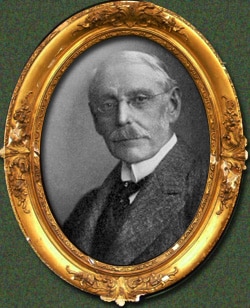
The steam turbine
This famous Engineer invented the first compound steam turbine, which has a tremedous impact on the ability to ships of all size to achieve great speeds. Born in 1854 in Ireland, he spent his carrer as an engineer, working for Armstrong, and later Clarke, Chapman and co., working on several devices including rocked-powered torpedoes. Starting from the Gustav de Laval turbine, he improved it in 1884 and created a new model of turbine designed to create a heavy load of electricity. Then in 1889, he founded the C. A. Parsons and Company to built turbo-generators. His first megawatt turbine was built in 1899 for a german plant. Then he made a compact design to be part of a ship propulsion, founding the Parsons Marine Steam Turbine Company in 1897, always in Newcastle.
His first ship, the turbinia, a fast yacht, was intended to demonstrate his ideas to the admiralty. The very same year, he displayed the ship at the Diamond jubilee of queen Victoria, and the lavish naval parade held at Portsmouth in june, before the eyes of the admiralty and the Royal family, reachig an amazing speed of 34 knots (at this time, the fastest torpedo-boat was using triple expansion watertube boilers were barely able of reaching more than 27 knots…) So this was an instant success, quickly followed by two experimental destroyers ordered by the First sea lord, then two liners, and eventually ending with the revolutionary HMS Dreadnought in 1906… Since then, the Parsons turbines were used and patended or built under licence everywhere. In 1930, some turbines-propelled cruisers were capable of reaching speeds of 42 knots and more…
Babcock and Wilcox
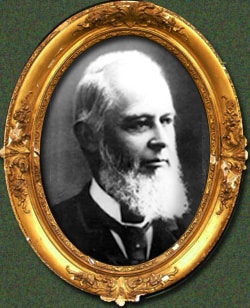
The watertube boilers
These two American engineers (Georges H. Babcock and Stephen Wilcox) devised the boiler water tube, making it much safer than before. This type has a single drum, with feedwater drawn from the bottom of the drum into a header that supplies inclined water-tubes. The water tubes supply steam back into the top of the drum. Furnaces are located below the tubes and drum. Other boilers were also remarkable like the Stirling boiler, which was a four-drum model, and the famous Yarrow boiler, with a three-drum design in delta formation connected with watertubes. Later, they built the triple expansion watertube boiler, which was the most efficient boiler arrangement ever created, making the ship really fast, although not as fast as turbine ship.
David Bushnell

The first military submarine
Co-inventor of the submarine, Bushnell was the author of the “Turtle” which he presented to both the Royal Navy and Napoleon, he was not convinced … David Bushnell, born in 1740 at Westbrook, Connecticut was a prolific American inventor, which started his carrer as soon as 1775, when a student as Yale university, while creating the “Turtle”, during the american revolution. He first made the first time bomb in order do sunk british warship anchored at New York Harbor, while piercing their hull to implant the bomb, but their iron protection was just impassable.
The second attempt made, with the turtle, was to place a mine alongside HMS Cerberus at Niantic Bay. Be he instead sunk a light vessel which was moored alongside and this was a failure. Two other attemps was unsuccessful. He ended the war as captain of a special elite unit, the “Corps of Sappers and Miners”, created by Washington in 1778, then travelled in France after the war, unsuccesfully trying to convince Napoleon to built his submarine. He ended his life as a professor in Warrengton , Georgia in 1824, but was honored before his death by a medal by Washington and is still revered by US Navy today.
Maxime Laubeuf
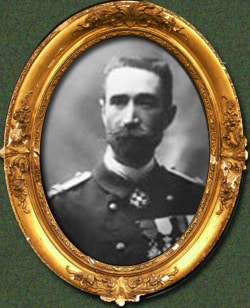
The first true modern submarine.
While Bushnell is still the true father of the submarine, we can only recognize Laubeuf as making the first truly efficient, modern submarine. Born in 1864 at Poissy, near Paris, he was graduated of the Ecole Polytechnique, and then, the ENSTA, the marine engineers school. In began his carrer in 1891 and soon became interested in submarines. In 1905 there was an admiralty request for a new mass-production and advanced capabilities submarine: They required a 200 ton vessel with a surface speed of 12 knots and a 100 mile range, with a submerged speed of 6 knots and a 10 mile range.
There was 29 responses, and where more prestigious engineers still struggling around complicated designs which has excellent submarine capabilities but poor surface performances, he just took the hull of a torpedo boat and made it submersible, reversing the concept, and doing so, he gave the Narval excellent surface capabilities and greatly enhanced its range and overall efficiency, along with other improvements, winning the competition. The admiralty was impressed and soon after purchased two classes of Laubeuf style submarines. It quiclky became a standard. After it, german, italian, and japanese submarines were built on the same model, while soon, the American Holland-type used by American and British navies were also replaced by Laubeuf style submarines.
INDUSTRIAL ERA NAVAL TECH
Steel industry: The great revolution of naval artillery
Steel for example, originally embryonic, becomes accomplished to the point of allowing the melting of metal plates of large dimensions, ad also making larger shells, and duplicate more easily all the parts associated with a specific machinery. The traditional timber could’nt satisfying anymore any fleet because of its own limits of endurance loads, heat, moisture… The steel industry also made it possible to design composite plates of different metals and alloys, hence the origin of the very first composite armor plates which were the mainstay of the Ironclad era.
More importantly, the techniques of modern fondry bring a marked increase in quality for lower price. Thus, it was common for the guns to crack and explode in the eighteenth century, depending of their origin. It is estimated as well as the quality of the original molding template, it could take a number of lined before reaching their limits of strength and become dangerous to their users. With the science of modern steelmaking, more longer guns were produced, while being more reliable and durable, playing on the assembly of parts to create a recoil brake already built into the structure of the canon, to adding an alloy core more resistant to heat, and especially to create a trustful mechanism for breech loading. Tactical advantages were obvious : Breech loading was easier and faster in the heat of battle, range was greatly increased, now reaching ten miles and more, and maintenance was also easier.
The passage of the SBML (Smoothbore muzzle loading) to the RML (Rifle muzzle loading), to the RBL (Rifled Breech loading) was effective around 1850, altoough many ships in 1880 still bear both RML and RBL. At that time, the first drying breech guns were still unreliable and many gunners had serious suspicious of it. But the conservatism ended with the development of these, and from an elite minority alongside the muzzle-loading, have become the majority, and in 1865, the exclusive dotation of any warship, in any caliber.
The process of rifled barrels was already ancient and had the function of the projectile to rotate very fast, as resulting in better penetration into the air: The result was that same length and same caliber guns became both increasingly accurate, and with greater range. But as they were still few armouries capable of producing such gun (one by country-only speaking of the greatest at the time), they were expensive and generally the biggest guns on board, only two or four of these being produced per ship.
Gunnery improvements
The classical smoothbore gun in use since the time of the Renaissance was built of rough casting in bronze or iron, usually garnished with side handles that were used in fact to its handling by pulleys, on a natural lever point. The cannon bore was sometimes constituted of a different metal, treated to be more resistent, an early attempt of composite guns. The gun was based on a mobile carriage (in depth) consisting of a wooden base mounted on wheels on which rested two media surrounding the tube, resting on cylindrical bulges at the base of the barrel. The Canon was aimed thanks to a primitive wedge-shaped wooden insert at its base, just hammered more or less. The recoil was reduced through a combination of wheels on the lookout and its attachment to the internal wall of the battery by a system of pulleys (brague to hoists), which deadened the energy released when firing.
The recoil of the barrel was calculated for the team of gunners to reload the mouth, to relent operation that requires hoists for the fall even in the middle of the bridge battery, a pre-cleaning with the swab, “sweeping” the tube to extract soot and deposits resulting from combustion, and the laying of the loose powder wrapped in a canvas bag pushed to the bottom of the barrel, loading the ball in the same way, then re-positioning by traction the whole lot to the wall by pulling on the hoist of Brague, and then reloading the flint hammer. Because of the dangerousness of the blow to the GPO, the latter, after setting up, by pressing the corner to the desired depth with a mallet, retreated and pulled on the rope that freed the dog. It was also customary in a heavy fire to throw buckets of water on the barrels of the guns, an ever dangerous operation because the under the thermical schock, the already developing cracks in the barrel could result in an explosion in the face of the crew on the next shot. It was also used to spread sand on the deck so that men do not slip on the blood of victims of splinters, the main result of the impact on even a thick wooden composite wall…
The whole operation took about twenty seconds on average, but officers were trying to bring batteries that number to fifteen or even twelve to respond more quickly to the adverse ship. Some dashing and able captains, even made hard-turns, allowing them to use their opposite broadside. Some extreme-aiming methods included the removing the rear wheels of the carriage to further increase the rise, especially when it came to get the opposite ship dismasted (to fire over the battery on the basis of masts, or cut the rigging with the infamous chain-shot).
Standard shots were sometimes replaced by a hotchpotch of pieces of iron, grapples, or grapeshot against the crew and riflemen of the enemy ship. For each gun, five to nine men were necessary, which explains the importance of crews piled on sixty meters of a vessel. The lateral aiming of the broadside was limited, the ship was simply steered around towards the goal, and usually lost the use of the battery from the other side during classic engagement (although, as specificed above, smaller and more agile vessels can compensate their lighter broadside by just swapping sides, allowing the other to reload).
The classical tactic of the “line” of battle, ships following and fighting at close range (less than 500 meters due to the very poor accuracy of the guns), and the origin of the “ship of the line” class, then passed to the “battleship” class in more modern way is meant to cook during the Second World War. One of the favorite tactic was to try to outflank the back or front of the queue to move opposite to the other side and thus make use of its other broadside, while keeping the line. Pass astern of a ship was also a tactic to destroy its rudder, paralyzing it at the same time. Nelson favorite tactic, usually in numerical inferiority, was to create a local numerical superiority by sending his ships in two parallel lines on each side of the enemy line. This “sandwiched broadside” tactic was a gamble : dealing with the biggest enemy ships – including the flagship, and have all of them destroyed, and the entire fleet was supposed to collapse. This was the case both at Trafalgar and Aboukir.
Revolution in gun aiming : Turrets and Barbettes
With the progress of the industrial age, the gun will change considerably during the 1870s, several successive revolutions: First, thanks to new alloys, including steel, machine guns could be fitted with a cylinder head opening. The moving parts makes it possible more or less than loading projectiles breech. The loading operation was thus significantly facilitated and the decline of the room did not need to consume an important place in the bridge battery. But he still had many detractors and not really required until about 1890. Another innovation was to place the cannon on a swivel looking metal side. We asked this because looking on rails in the halfpipe, which enabled the roll in position angle of 80 to 90 degrees, compared with the previous zero angle guns. Swivel guns and allowed the ship to keep its road and to fire or is the goal. And we are moving to a smaller number of guns, but orientation and larger caliber, which would give the central battery ironclads.
It must be on site Columbia Elswick Armstrong and English engineer Ericsson inventing a new type of brake down more suitable, consisting of metal strips placed on the rails Parallel and friction with other vertical stripes constitute the look-out and a mechanism to allow channels to put the unit in place, but everything was still working at the force of arms. With guns than twelve tons, it was appropriate to consider another solution: We will then proceed on hydraulic brake and not mechanical, and secondly, for pointing to the solution of the watch mobile turn, the forerunner of the turret. In 1861, the United States, the Stevens brothers had devised a battery of high seas with fully adjustable mounts on guns in all directions. This brilliant precursor was not followed.
By John Ericson against the Americans proposed a “turret” avant-garde as gun carriage and turned all screening. This leads to the ship that becomes universally known minimalist: the monitor. This system, however, was quite heavy because the turret was placed on a shaft and rested on the bridge, it was a powerful mechanism for the hydraulic lift and rotate to the desired angle. In turn, the Englishman John Coles, commander of active conceived and proposed an improved turret system. The principle remained the same, but the turret rested permanently on the bearings, which simplified its rotation. Faced with the skepticism of the British Admiralty (short term), Coles offered his invention to the Danes who adopted it for their monitor Rolf Krake in 1864. The French in turn, used a system but also turning barbette, the screen is quite low and the gunners were not protected. But this system conut long success through simplicity in particular to ensure the loading maneuvers.
The site was then Elswick Armstrong-simplify and refine pointing maneuvers, loading guns, by inventing a system based entirely on water power rather than steam. By 1890, this system became the majority, and radiation technique (and commercial) would give the site a large majority position in the production of naval ordnance, and shipbuilding itself. The quality of the British steel industry was also profier to the melting of parts much longer: The “size” is the measure of length comparison between the fly (length of the gun tube from the base of the cylinder head to the mouth), and diameter. And 1850 guns with calibers from June to August, they went to 20 gauges around 1875. This siginfiait also through the introduction of shells, a much greater range, from less than 1000 meters to over 5000. With heavy-loading cannon’s mouth who survived still remained the problem of loading, which was solved with creative solutions and varied: for example, are oriented in a transverse position on the lookout sets, and switch on the fly was down so that the bolt is in the air and the mouth in the bridge battery. we also put a system of lift, or all bolt-gun-turret came down to a level …
About 1895, they began to move away from barbettes poorly protected against fire for oblique and full towers are especially concentrated on a loading system allows to do this regardless of their angle of fire. The loading system evolved, as shells were now lifted from the ammunition storage rooms by a system located in the axis of the turret. The shell and cartridge (powder charge usually surrounded by paper) was then brought by a chariot or a reinforced mat. Then, early in the century, innovation is still possible that loading at any angle, expanding down the entire turret. This system is still in use on the modern automated turrets.
Ammunitions: From cannonballs to AP shells
Another fundamental innovation, initiated in 1860 concerned the ammunitions: Navies dropped the cannonball and its derivatives such as Paixhans explosive special grenade. The latter, invented by engineer Henri-Joseph polytechnician Paixhans is neither more nor less than the precursor of modern HE shells. It was established in 1819 and proposed to a commission of officers and technicians of the Army. But it was not until 1854 that Napoleon III, after the death of the person concerned, decided to build three armored batteries illustrating his theories successfully. Long before Paixhans, Carron invented the famous “carronade” naval guns firing angle firing explosive bullets. It was a resurgence of neither more nor less than the spread of mortars in use on marine galiots since the seventeenth century. Nevertheless Paixhans brings the power of explosive projectiles form studied and the ability of these guns to shoot horizontally. Rockets were also used in naval warfare, and cannons could be loaded by chained cannonballs, red hot ones, or canister shots to precede a boarding.
The “bombs” more or less spherical and hollow, came to form ballistic shells studied from 1870. It is the latter, which combined with a scoring of the bore and longer length of the fly will move progressively from 20 000 to 40 meter range 000 of the first to the second world war. The shells of modern rooms are equipped with large deployable wings and provided with additives that brought charges that distance over 100 km, not counting the giant guns recurrence projects since the beginning of the century and the nineteenth century (the gun running the rocket “from Earth to the Moon” by Jules Verne).
Revolution of Steam
(To Come)

 Latest Facebook Entry -
Latest Facebook Entry -  X(Tweeter) Naval Encyclopedia's deck archive
X(Tweeter) Naval Encyclopedia's deck archive Instagram (@navalencyc)
Instagram (@navalencyc)





 French Navy
French Navy Royal Navy
Royal Navy Russian Navy
Russian Navy Armada Espanola
Armada Espanola Austrian Navy
Austrian Navy K.u.K. Kriegsmarine
K.u.K. Kriegsmarine Dansk Marine
Dansk Marine Nautiko Hellenon
Nautiko Hellenon Koninklije Marine 1870
Koninklije Marine 1870 Marinha do Brasil
Marinha do Brasil Osmanlı Donanması
Osmanlı Donanması Marina Do Peru
Marina Do Peru Marinha do Portugal
Marinha do Portugal Regia Marina 1870
Regia Marina 1870 Nihhon Kaigun 1870
Nihhon Kaigun 1870 Preußische Marine 1870
Preußische Marine 1870 Russkiy Flot 1870
Russkiy Flot 1870 Svenska marinen
Svenska marinen Søværnet
Søværnet Union Navy
Union Navy Confederate Navy
Confederate Navy Armada de Argentina
Armada de Argentina Imperial Chinese Navy
Imperial Chinese Navy Marinha do Portugal
Marinha do Portugal Mexico
Mexico Kaiserliche Marine
Kaiserliche Marine 1898 US Navy
1898 US Navy Sovietskiy Flot
Sovietskiy Flot Royal Canadian Navy
Royal Canadian Navy Royal Australian Navy
Royal Australian Navy RNZN Fleet
RNZN Fleet Chinese Navy 1937
Chinese Navy 1937 Kriegsmarine
Kriegsmarine Chilean Navy
Chilean Navy Danish Navy
Danish Navy Finnish Navy
Finnish Navy Hellenic Navy
Hellenic Navy Polish Navy
Polish Navy Romanian Navy
Romanian Navy Turkish Navy
Turkish Navy Royal Yugoslav Navy
Royal Yugoslav Navy Royal Thai Navy
Royal Thai Navy Minor Navies
Minor Navies Albania
Albania Austria
Austria Belgium
Belgium Columbia
Columbia Costa Rica
Costa Rica Cuba
Cuba Czechoslovakia
Czechoslovakia Dominican Republic
Dominican Republic Haiti
Haiti Hungary
Hungary Honduras
Honduras Estonia
Estonia Iceland
Iceland Eire
Eire Equador
Equador Iran
Iran Iraq
Iraq Latvia
Latvia Liberia
Liberia Lithuania
Lithuania Mandchukuo
Mandchukuo Morocco
Morocco Nicaragua
Nicaragua Persia
Persia San Salvador
San Salvador Sarawak
Sarawak Uruguay
Uruguay Venezuela
Venezuela Zanzibar
Zanzibar Warsaw Pact Navies
Warsaw Pact Navies Bulgaria
Bulgaria Hungary
Hungary

 Bundesmarine
Bundesmarine Dutch Navy
Dutch Navy Hellenic Navy
Hellenic Navy Marina Militare
Marina Militare Yugoslav Navy
Yugoslav Navy Chinese Navy
Chinese Navy Indian Navy
Indian Navy Indonesian Navy
Indonesian Navy JMSDF
JMSDF North Korean Navy
North Korean Navy Pakistani Navy
Pakistani Navy Philippines Navy
Philippines Navy ROKN
ROKN Rep. of Singapore Navy
Rep. of Singapore Navy Taiwanese Navy
Taiwanese Navy IDF Navy
IDF Navy Saudi Navy
Saudi Navy Royal New Zealand Navy
Royal New Zealand Navy Egyptian Navy
Egyptian Navy South African Navy
South African Navy






























 Ukrainian Navy
Ukrainian Navy dbodesign
dbodesign